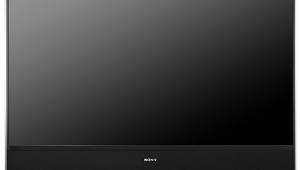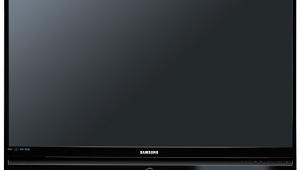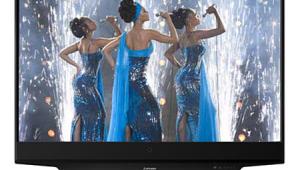Mitsubishi WD-52628 DLP RPTV Page 2
The Mitsubishi also incorporates TV Guide On Screen (TVGOS), which is a free eight-day program guide for cable, broadcast, and CableCARD reception. TVGOS looks really slick on paper and at trade-show demos, which is the only way I've experienced it. Sadly, TVGOS has never worked in my home – it seems that our town's sole cable provider, Adelphia, either blocks or strips out the TVGOS data that should be embedded within our local PBS affiliate's signal. I've read that this problem is not unique to my cable provider, so caveat emptor.
For as long as I can remember, Mitsubishi has at least made an effort to provide good remotes with their TVs. This one is large and fully illuminated, which is great. One wishes for direct input access, and it would be nice if the Format button used to switch between the screen modes was more prominently located. Still, this remote is a big improvement over most others.
My biggest complaint with the set's operation has to do with its clumsy input selection procedure. The remote has a large, up/down rocker switch labeled Device, but you can't use this to step sequentially through the inputs. Instead, pressing the Device rocker invokes an onscreen Device menu. That's step one. Next, you use the rocker to navigate through the devices on the menu until you reach the one you want. That's step two. Finally, you press Enter to engage that input. That's step three. As far as I'm concerned, that's two steps too many. In addition, because the rocker switch is oriented vertically and the menu horizontally, you often start off through the menu in the wrong direction, which requires even more button pushes to correct. Keep it simple, folks!
The hefty120-page owner's manual is well organized and includes a table of contents and an index. Also included is a separate 27-page guide just for TVGOS.
Picture Quality
Getting the set's picture into the ballpark is easy right out of the box. For each input you plan to use, call up Natural Mode and chose the Low Color temperature setting. While you're at it, set the Brightness control to 41, the Contrast 44, and reduce the Sharpness control all the way down to zero (your mileage may vary with a different sample and variations in the source, but this should get you in the ballpark.) Purists will want to turn off the SharpEdge and DeepField Imager functions; regular folks are welcome to experiment and decide for themselves.
Although editor Tom Norton and I experienced a few anomalous results on a couple of test patterns (see the "Tests and Calibration" section), none of that was evident in the pictures we saw on the screen from normal video sources.
One of my favorite test DVDs is Moulin Rouge!, specifically the "Can Can" and "Satine: The Sparkling Diamond" sequences. These scenes have it all: black tuxedos in dim, offstage lighting, hyperkinetic action, intense colors, and a wide range of skin tones from the ruddy face of Harold Zidler (Jim Broadbent) to the consumptive pallor of Satine (Nicole Kidman). The Mitsubishi portrays all of this in crystalline detail, never breaking a sweat. The blacks in particular are the best I've seen from a DLP rear-projector- the many tuxedos retain detail and texture, never collapsing into a black blob despite the difficult lighting conditions.
Mozart's 250 birthday happened to coincide with this review, and I couldn't resist marking the occasion with a few scenes from Amadeus. Although this disc can look a big grainy, the naturally-lit opera sequences look absolutely splendid on the Mits. Subtle colors, intricate textures, rapid changes in depth of field – all of this film's masterful cinematography is right there on the screen in sumptuous detail.
I especially admire this set's ability to handle color. The sun-drenched vistas of the time-lapse IMAX film Chronos look luminously natural. The greens in particular are just right, with none of the hyped, fluorescent quality that marred early DLP sets (and still plagues many of them). On the other, less natural end of the color palette, Robots and Finding Nemo are pure eye-candy on the 52628, with fully saturated colors that practically vibrate in their intensity.
Finally, I've never seen the difficult opening sequence from Star Trek: Insurrection so smoothly rendered. Many sets choke on this long, traveling shot, which slowly pans across a bucolic village that could have been purpose built as a video deinterlacing/processing torture test. On the Mitsubishi, the ripples in the pond are rendered as perfectly clean arcs and the stepped diagonals of the building roofs are completely free of jaggies. It's a virtuoso performance.
My HDTV signal source is Adelphia cable, and they have a sad tendency to crank the compression up to 11. Picture quality varies from channel to channel and even from minute to minute, and macroblocking is not an uncommon sight. Still, when the signal is optimal, the Mitsubishi produces the finest HD images I've seen from a RPTV.
Good HDTV images can appear exquisitely detailed on this set, as you'd expect. But as far as I'm concerned, the extended resolution is icing. What really makes you sit up and take notice are the wide dynamic range, the shadow detail, the color accuracy, and the relative lack of once common DLP artifacts such as false contouring, rainbows, and noise.
Finally, the Mitsubishi handles analog cable channels much better than most HDTVs, which can turn these channels into a nasty, noisy hash. Watching a basketball game on ESPN or a dog show on Animal Planet is far from unpleasant, but once you become used to a steady diet of HDTV and DVD, the blurry low res images might have you wondering if it's past time to have your eyes lasered. To summarize, the Mits does nothing to disguise the lack of detail in the source, but it doesn't make things worse, either.
Conclusion
The Mitsubishi WD-52628 is one of the best-looking DLP RPTVs on the market, and represents a significant advance in picture quality beyond the DLP models I've seen and reviewed in the past. It's extremely well connected, with multiple HDMI, component, and FireWire inputs. It has every feature you could ask for, and a few features that you probably could live without. In fact, you can save about $200 by opting for the WD-52627, which is the same exact TV minus two superfluous video "enhancement" features.
If you were turned off by earlier DLP models, or are just waiting for them to work the kinks out of the technology before you dive in, it's time to take another look. This isn't just another superb-looking RPTV – it's a whole new ballgame.
Highs and Lows
Highs
1080p chip raises the bar for DLP RPTV performance
Extremely well connected, with two HDMI and three component inputs
Two complete sets of picture adjustments for each input provide "day/night" adaptability
Frames 4:3 images with black bars, not gray, and has at least one useful mode for stretching 4:3 sources to 16:9
Lows
Clumsy, multi-step input procedure
Video processor had problems with certain test patterns
Some frequently used buttons on the remote are poorly placed
- Log in or register to post comments
























































